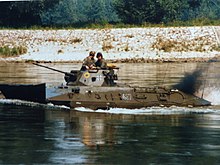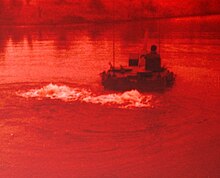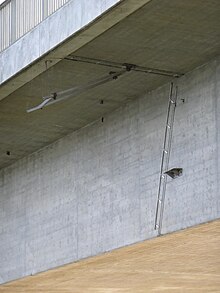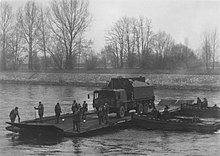Battle for waters
The struggle for bodies of water , which present obstacles in the terrain and severely impede mobile land operations, is one of the common military operations of land war. During a possible tank war in Central Europe , overcoming waters on the part of the attacker and the use of obstructive waters on the part of the defender was of great importance. The pioneer troops , in particular the bridge pioneers (organized in heavy engineer battalions or engineer bridge battalions), played a central role in combat support.
Overcoming water obstacles
Floatable and watertight tanks
Shallow and less wide waters can be crossed by the combat troops independently with deep-water tanks or floating tanks / amphibious tanks . Certain types of tanks of the Bundeswehr (e.g. Leopard 1 , Leopard 2 , Marder infantry fighting vehicles ) and the Warsaw Pact ( T-72 M and others) are deep-water capable. You are able to travel through a body of water with a certain maximum depth by rebuilding the tower (deep wading with deep wading shaft or underwater travel with underwater shaft). For a time, the Bundeswehr was using an amphibious variant of the Luchs reconnaissance tank , which was able to carry out a reconnaissance mission in front of the VRV of its own troops and largely without the support of the engineer troops.
Several types of tanks were buoyant on the Warsaw Pact side. This included the BMP-1 , the light swimming and battle tank PT-76 , and other models. This was based on their military doctrine of being able to deploy quickly, to form bridgeheads on the hostile side of a body of water and to secure them for subsequent forces.
Overcoming water obstacles with the help of pioneers
A combat troop regiment (Pz / MotSchtz) is dependent on the cooperation of a heavy engineer battalion in terms of strength and size. The time taken for the attack depends u. a. depending on the prevailing visibility, while darkness favors both the covered advance and the actual translation activities. The combat force gives the order to take the crossing points of a certain stretch of water in one fell swoop, in phase 2, to form bridgeheads and thus to create the conditions for the attack of the main forces.
A general distinction is made between transition points:
- Translation agencies
- Passage points for tanks that can be waded or floating points for floating tanks
- Ferry stations or
- Bridge places ( war bridge )
A water crossing can be forced with the following means:
- Ferry operation with pioneer ferries such as the Amphibian M3, folding swimming bridge device (FSB) and hollow plate bridge device (HP)
- Armored bridge
- War bridge as a folding swimming bridge or amphibious
The use of the requested pioneering resources depends in particular on the military load class and the duration of the transition required (ferry service or permanent war bridge).
When planning a waterway crossing, the width of the water, the bed of the water (mud, sand, etc.), the nature of the embankment and, above all, the flow speed (highest speed on the current line ) play a major role. In addition, the nature of the banks, navigability and load-bearing capacity of the ground for heavy tracked vehicles and large military equipment belong to it.
The easiest way to cross smaller bodies of water is to use armored bridges to create rapid armored bridges .
War bridge
War bridges ( en. Prefabriated bridge, military bridge or engineer bridge) are military bridges for the movement of one's own forces over a water obstacle. Depending on the location, there may be an alternating transition between ferry operation and operation of a war bridge. War bridges often have to be removed, relocated or, in exceptional cases, destroyed again quickly after their use. The transit and control points for regulating and monitoring the land march over a war bridge are taken over by the bridge commander.
Folding swimming bridge
The Bundeswehr's folding swimming bridge is the most common form of a floating war bridge (rapid floating bridges). It consists of several pontoon sections that are coupled and connected with one another directly on the water with the help of motor boats.
Forcing waters (Warsaw Pact)
In order to be able to wage a successful war of aggression in any terrain, the Soviet Army intensified its amphibious capacities, which were used to overcome bodies of water as quickly as possible ( "force watering" in the parlance of the NVA ) in order to enable armored forces to be transferred. This ability was indispensable, especially when a tank penetrated the North German Plain in the multitude of natural ( Ilmenau , Aller , Leine etc.) and artificial waters ( Elbe-Lübeck Canal , Elbe Lateral Canal , Mittelland Canal etc.). The Soviet Army was known to have a high degree of water mobility during the Cold War. B. practiced amphibious operations on the great rivers in Siberia on a large scale .
The most common folding swimming bridge system (FSB) used by the Warsaw Pact armed forces in the 1960s was the PMP folding swimming bridge (pontoon park "P") made of aluminum- light metal . The US Army's ribbon bridge system was derived from this.
Possible sequence
In the first stage of the reconnaissance, suitable water crossings (main and alternate crossing points), as well as sham crossing points, are explored in order to be able to carry out the operation in a terrain that is suitable from a tactical point of view. In the initial phase there are mostly transition points (ÜgSt) for light transition means such as inflatable boats with or without an outboard motor or for larger bodies of water for assault boats . During the exploration, covered approaches for transitional means, staging areas and building sites for transitional means and the deployment point for boats, if possible with consideration of cover and camouflage, as well as protection against enemy weapons. Before the transition, a connection is established between the leader of the combat troops and the leader of the pioneer troops. As soon as the floating bridge is in place, the combat troops cross over with parts of wheels and chains after a certain marching sequence. In addition to the actual bridge crossing, rescue equipment (armored vehicles in the event of an accident) and medical supplies must also be taken into account.
The water crossing is mostly supported by a previous air landing by paratroopers or airborne infantry with transport helicopters in order to form a bridgehead on the other side of the water . Since a water crossing or the construction of war bridges often leads to a massing and damming of one's own troops and thus provokes air attacks by the enemy, extensive surveillance by one's own air defense is of great importance. Artillery forces are also instructed to monitor and secure the transition by observing fire or by being ready to fire.
In a combat situation, ferries should allow crossing at several ferry points in order to avoid a total failure. The transfer forces and resources are called up from a position or cover near the water. During the ferry operation, the translating vehicle must remain ready for action in order to be able to fight any threats from the other bank. Makeshift walkways can be built for transferring infantry.
A company order for building war bridges could read as follows:
- Order: "5./PiBtl builds war bridge MLC with FSB device over ... at ... (coordinates), alternative bridge point at ... (coordinates). Bridging the gap ... "
- Implementation: “I intend to work with the FSB train, the FSB support train ... Kp, PiMaschZg, TaGrp and Tle FmZg. 1. / ... FSB of m length with IA / ... RA at ... insertion points. "
Defense of water obstacles
Waters are defended with bridges, barriers and field fortifications prepared for demolition, taking into account the evasion and the absorption of one's own troops (e.g. cover or delay forces ) from the upstream combat zone.
Blocking value of water obstacles
When building numerous canals running in a north-south direction, a possible inhibiting effect on Warsaw Pact armored vehicles was taken into account. The construction of the Elbe-Lübeck Canal had a certain blocking effect, which enabled a tank from east to west to enter over the east bank, but not to drive on the western bank, which is prevented by underwater piles near the bank has been. This was tested in a drive-through test with floating and submersible vehicles ( MTW M113 , TPz Fuchs , KPz Leopard 1 and SpähPz Luchs ) of the Bundeswehr in 1984. In the case of more recent canals such as the Elbe Lateral Canal , the blocking effect was already taken into account in the construction of an oversized embankment as a tank obstacle and bridge detonation shafts and was firmly integrated into the defense planning. In order to severely hinder a tank advance from the east, the demolition of sections in certain areas of the terrain and an artificially created flooding of the enemy approach zones were considered.
Bridge demolition
Blasting bridges is normally one of the prepared barriers , which are carried out by the detonation squads or the pioneers' detonators in accordance with the blast plan. The aim of a bridge blast is that the bridge is either partially destroyed in its function or at least that the roadway is no longer usable by the enemy. As a rule, cutting charges are placed at several points on the bridge structure in order to develop a high and targeted penetration force at certain points, so that the bridge collapses at least on load-bearing components according to static calculations. The task of the explosive charge is to also “cut through” steel and reinforced concrete components . It can be triggered with an electrical ignition and as a safety device for a pilot light.
The orders for the detonation are issued according to STANAG 2017 in accordance with the detonation order. Thereby u. a. the ignition cables from the charges to the ignition point and the level of ignition readiness increased. The demolition order is signed several times and given to the authorities involved, such as the superior command, the leader of the explosive security command and the leader of the explosive command. Command posts are often also used as an ignition point, since this is where the most important information comes together via field cables. After all of your own parts with their last marching group, which are deployed in front of the bridge to be blown up, have completely passed the checkpoint, the ignition can be triggered.
A bridge over an important water obstacle is often an exposed target against air attacks and fire strikes by enemy artillery , so that preparations must therefore be made for the reference to alarm positions in order to remain able to act afterwards. Bridges of strategic importance are also considered high-value targets for enemy air landings or commandos. The enemy tries to take possession of the bridge as undamaged as possible, so that his own troop movement can be ensured and must therefore switch off the fuses around the bridge. Depending on the nature of the terrain, it can also be expected that he will approach the target with shock troops on the water side.
The detonation order is given to the detonator leader as a cover word (according to the speech board) by radio. It is imperative that this be done promptly, before the bridge falls into the hands of the enemy. The demolition is triggered as soon as the last front alarm post avoids.
In the Federal Republic of Germany , all bridges that had a military blocking value were constructed in the construction planning stage so that the bridge could be blown up quickly. For example, the brackets for cutting charges and explosive charges were preinstalled in bridges, trailing cables were laid for the ignition cables, predetermined breaking points were built in and blocking books were created. The explosive ammunition was stored locally in pioneer ammunition houses or in ammunition stores. The maintenance and repair of such barriers were subject to the local Wallmeister troops in times of peace .
Pioneering device
NATO
- Bridge laying tank M48
- amphibious bridge vehicle M2 "Alligator"
- amphibious bridge vehicle M3
- Biber bridge-laying tank
- Bridge-laying armor iguana
- Bailey bridge system
- Mabey-Johnson fixed bridge
- D bridge
- FFB folding bridge
- MGB Fixed Bridge (Medium Girder Bridge)
- Floating bridge hollow slab device 50/80
- M60A1 Armored Vehicle Launched Bridge (AVLB)
- M4T6 pontoon bridge
- Pont Flottant Motorisé (PFM)
- Standard ribbon bridge
- Steel Ribbon Bridge (SRB)
- Improved Ribbon Bridge (IRB)
- Transport vehicles for the transport of pontoon parks
Warsaw Pact / Russia
- Towing boats
- "Carpet layer"
- Wheel swimming car BAW
- Chain floating car K-61
- Amphibious Landing Vehicle PTS, PTS-M, PTS-2, PTS-3 and PTS-4
- AM-50 , Czechoslovak express bridge system
- TMM , heavy mechanized accompanying bridge
- TMM-3 , heavy mechanized accompanying bridge
- TMM-6 , heavy mechanized escort bridge
- Bridge Laying Device-60 BLG-60M
- Bridge and transfer vehicle PDP
- Pontoon bridge machine PMM "Wolna"
- Pontoon bridge machine PMM-2 / PMM-2M
- Pontoon Park PMS
- Pontoon park PPS-84
- Pontoon Park PP-91
- Pontoon park PP-91M / PP-2005
- Pontoon Park PP-2005M
- Pontoon Park LPB
- heavy pontoon park SPB
- heavy pontoon park TPP
- heavy pontoon park PMP
- heavy pontoon park PMP-M
See also
- Type of operation
- Tank Pioneers (Bundeswehr)
- Riverine Operations in the Vietnam War
literature
- Bundeswehr: HDv 100/1 troop command . Ed .: Bundeswehr.
- Bundeswehr: HDv 100/100 leadership in battle . Ed .: Bundeswehr.
- Bundeswehr: HDv 287/100. Overcoming bodies of water and cuts with the support of pioneers . Ed .: Bundeswehr.
- Bundeswehr: HDv 288/300. Temporary bridge construction . Ed .: Bundeswehr.
- Bundeswehr: HDv 288/301. Construction of makeshift bridges . Ed .: Bundeswehr.
- Bundeswehr: ZDv 3/703. Overcoming waters and cuts . Ed .: Bundeswehr.
- Rainer Oestmann: I order that ...! Manual for military leaders. Management process up to division level . Walhalla-Verlag, 2012, ISBN 978-380-296023-9 .
- Dietrich Biewald: Pioneers in the 8th Motorized Rifle Division of the National People's Army of the GDR. Edition Digital, 2016, ISBN 978-395-655612-8 .
- Use of artillery in the battle for waters . Troop practice 6/1983. Darmstadt, Wehr und Wissen publishing company.
Web links
- Bundeswehr soldiers attacking a body of water (film footage)
- Attack across a body of water (photos)
- Classix: Fast Bridge (1979) - Bundeswehr. How a folding swimming bridge works (film recordings)
- Translation technology. Buoyant technique overcoming water hazards
- The NATO Bridge Family (en.)
- The explosion protection squad. The Demolition Guard. BAOR. Bundeswehr British Army (educational film 1980s)
- Bundeswehr: ZDv 3/703. Overcoming waters and cuts . Ed .: Bundeswehr.
Notes and individual references
- ↑ a b c d e f Rainer Oestmann: I order this ...! Manual for military leaders. Manual for management process up to division level . Chapter 712. Encouraging and inhibiting movement. 712.4. + 712.5. Attack over waters. 712.6. Combat troops - pioneers and 712.7 water mobility of the army. Walhalla publishing house. 2012. p. 1003ff. ISBN 978-380-296023-9
- ↑ prefabricated bridge from individual bridge elements
- ↑ "Pioneer Bridge"
- ^ War bridge in pontoon construction
- ↑ The inner and outer floating bodies are connected to one another by hinges
- ↑ Folding swimming bridge system (Bw)
- ↑ Bundeswehr. Ferry and bridge at the same time: The FSB 2 of the pioneers
- ↑ OTL Claus Roser and Maj Fritz Gehrmann: Faltschwimmbrücke - the new war bridge of the division pioneers. Troop practice 9/1980. Darmstadt, Wehr und Wissen publishing company.
- ↑ MLC: Military Loading Class: Military load class
- ^ Elbe-Lübeck Canal obstacle (film from September 1984)
- ↑ Completion 1976
- ^ Canals in Germany: The Elbe Lateral Canal. The canal built during the “Cold War” established the connection between Hamburg and the Mittelland Canal
- ↑ Expressway for ships. The Elbe Lateral Canal
- ^ The Land Forces in Lower Saxony. Cold War relics
- ↑ NATO - STANAG 2017. Orders for the Demolition Guard Commander and Demolition Firing Party Commander (Non-Nuclear) (English)
- ↑ In the Bundeswehr: STANAG No. 2071. Orders to the leader of an explosive security squad
- ↑ Ready to ignite from one to two
- ↑ The Explosive Security Squad. The Demolition Guard. BAOR. Bundeswehr British Army (educational film 1980s)
- ↑ for the electrical ignition
- ↑ Wallmeister. Retrieved June 7, 2020 .
- ↑ Keeper of the barriers. Bundeswehr, accessed on June 7, 2020 .
- ↑ Jonas Erlenkämper: Forgotten shafts from the Cold War. February 23, 2013, accessed June 7, 2020 (German).
- ↑ Michael Grube: Prepared barriers on Germany's roads. Accessed June 7, 2020 (German).





















